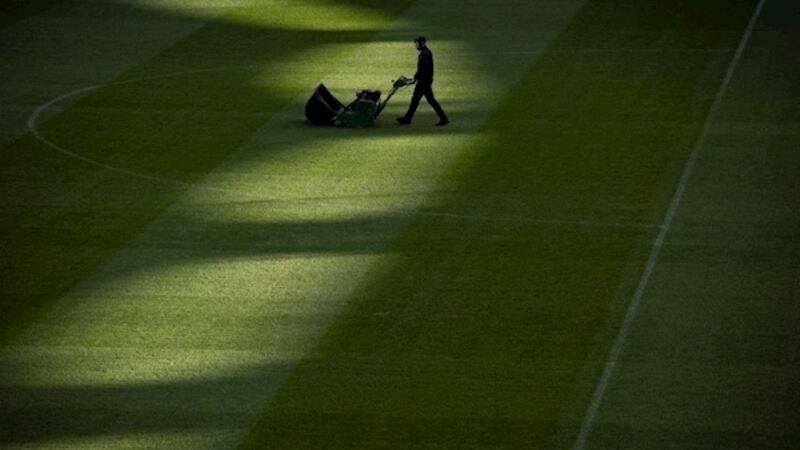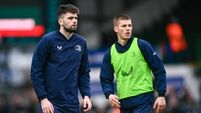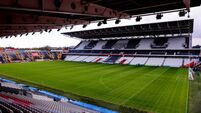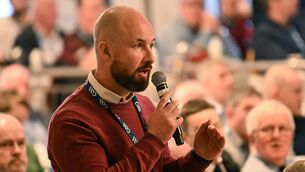Pitch expert points to challenges of maintaining green green grass of home

Leaving playing surfaces untended can be as counterproductive as overuse, warns a leading pitch maintenance expert.
Stephen Forrest of Turftech, which works with Munster Rugby and the Cork County Board, says a ‘one size fits all’ approach doesn’t work for playing pitches, however.
“Every pitch is different because of the sport played there, because of the budget, because of the location — there are a lot of factors involved, but there are a few basic rules which cross all sports and pitches.
“Mowing is one — the mowing is the single most important thing to be done on a playing pitch. The frequency of the mowing is probably the most important part of that — we’re not yet in the full growing season but I’d be recommending that clubs try to achieve two mows a week.
“In the height of the growing season, depending on your sport and your resources, you’d be trying to achieve between three and four mows a week.
“The next most important thing is the equipment, and the most important aspect of that is that the equipment is well maintained, set at the correct height — in GAA terms that would be between 30 and 35 mm — and that all blades are sharp.
“People would discuss what kind of equipment is best, and if people look at the big stadia in the country they’ll see walk-behind pedestrian cylinder mowers, but that’s not realistic for clubs at all.
“What’s realistic for clubs is the machine they have at hand, whatever that is, should be set at the correct height and maintained — that it’s greased and not leaking oil or anything like that, and that the blades are sharp and sharpened regularly.
“After that it’s a question of looking at goalmouths and damaged areas from winter training or whatever, looking at the levels of those areas and adjusting them if need be with good quality soil or a sand-soil mix.”
Is the current lockdown an opportunity for pitch custodians to carry out necessary remedial work?
“In an ideal scenario, this is the perfect time of the year to have no use of the pitch because it would allow you to carry out necessary works — again, depending on your budget.
“I’m a member of Blarney GAA and we have a normal budget — we mow with good quality gear and aerate to de-compact the soil in order to ensure the grass has a better environment. We feed the soil and address areas that may be thin with grass or have no grass, like goalmouths.
“An area without grass — rest or no rest, that area won’t grow grass without seeding it. It won’t fill itself in miraculously.
“So it’s an ideal time to have the pitch rest, but you still need to carry out work to get the full benefit from that period of rest.
“The guidelines which came out initially stopped unnecessary work, and grass mowing was deemed part of that unnecessary work.
“The GAA’s National Pitch Work Group, which I’m a member of, worked hard to highlight the importance for clubs and county boards of getting some kind of access to county grounds in particular — observing HSE guidelines — to maintain the investment that has been put into pitches across the country.
“Once that hurdle was cleared at least stadia could maintain what was already there, if not gaining ground because of the break.
“If the grass is left to grow out of control then what happens is the grass density thins out and there’s more opportunity for an organic layer build-up, which affects the drainage performance on these pitches, which is always under scrutiny.
Those elements are still not ideal but as time goes on the National Pitch Work Group is working on getting new guidelines released so that county boards and clubs alike can do the necessary work as the seasons change.
“A few months back when this started, for instance, grass growth wasn’t a big deal — one cut a week and walking the pitch to make sure everything was ok, that was reasonable necessary maintenance. That was fine.
“Now the seasons are changing and temperatures are coming in, there’s more sunlight, and more work will be necessary whether those pitches are being played on or not — mainly to maintain the investment in the grounds. County boards invest a lot of money in their pitches and that investment must be protected.”
Forrest points out that playing games is beneficial to the health of the pitch.
“Just letting a pitch sit there, mowing it and not having play on it can be as counterproductive as too many games, maybe even more so.
“Take a pitch which might be 80% sand and 20% organic matter which allows grass to survive in that environment.
“For such a surface to perform to the optimum, you need to maintain that balance of 80-20%.
“Grass produces its own organic matter by leaves dying off so it’s growing up all the time. That needs to be controlled, though, and if you don’t the pitch performance deteriorates more rapidly than people might realise.
“By its nature, play on the pitch is disrupting the surface of the pitch all the time, breaking down and helping the roots to deal with organic matter — as well as the groundsman’s practices.”
Finally, the look of the pitch isn’t the top priority.
“You’re trying to produce a surface that suits the particular code being played there,” says Forrest.
“People might think that a groundsman’s aim is to produce a picture-postcard surface for everyone to look at, but that’s not what it’s about.
“Player safety is number one, playability is number two, and the aesthetics is number three.
“It’s nice to have the pitch looking good, everyone has pride in their work, but the proof is when there’s a game and the pitch performs.”














